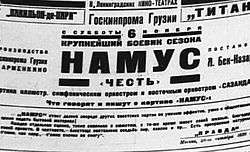Namus (film)
| Namus | |
|---|---|
|
A scene from the film | |
| Directed by | Hamo Beknazarian |
| Based on |
Namus by Alexander Shirvanzade |
| Starring |
Hovhannes Abelian Hasmik |
| Cinematography | Sergei Zabozlayev |
Production company | |
Release dates | |
Running time | 62 minutes |
| Country | Soviet Union |
| Language | Armenian (1960s voiced version) |


Namus (Armenian: Նամուս, meaning "honor") is a 1925 silent drama film by Hamo Beknazarian,[1] based on Alexander Shirvanzade's 1885 novel of the same name,[2] which denounces the despotic rites and customs of Caucasian families.[3][4][5] It is widely recognized as the first Armenian feature film.[6][7]
History
Background
The Armenfilm studio was founded two years later, on April 16, 1923 as the State Cinema Organisation.[8] Hamo Beknazarian, who was an actor prior to the 1917 Revolution, became actively involved in directing films after the Bolsheviks took over.[9] Namus became his first notable work as a director.
Production and reaction
Namus was first premiered in Yerevan's Nairi Theatre on April 13, 1926.[10] On October 3 of the same year, the film was presented in Moscow.[11] A poster in Leningrad in 1926 called Namus the "biggest blockbuster of the season".[12] When asked about the film, Hamo Beknazarian said "I wanted to set the power of custom in the pillory, that stupid force of the concept of "father's honor".[10] The film had incredible success and brought Beknazarian to fame in the Soviet Union, which helped him in his later works, making him the founder of Armenian cinematography.[7]
Restoration
The first attempt to restore the film was made in the 1960s, when it was voiced.[10] In 2005 Namus was digitally restored by Franco-German network Arte.[10][12][13] This version was first shown in Cinéma Le Balzac in Paris in November 2005[12] and then in Moscow Cinema in Yerevan in April 2010.[10]
Plot
The story is set in the Caucasian city of Shemakh, which was a provincial town in pre-revolutionary Russia. The love story involves Seyran, a son of a potter, who secretly meets with Susan, to whom he is engaged. The Armenian customs didn't tolerate this and strictly prohibited such behavior. When a neighbor catches them during one of their secret meetings, rumors of their actions spread around the neighborhood and her family decides to marry her to another man, in order to restore the family's honor. They choose Rustam, a rich merchant, for Susan to marry. Seyran slanders Susan by saying that he owns her. Rustam kills Susan, considered himself disgraced by Seyran's actions. And the end Syeran commits suicide upon hearing about his lover's death.[11]
Cast
- Hovhannes Abelian as Barkhudar
- Hasmik as Mariam
- Olga Maysurian (hy) as Gyulnaz
- Hrachia Nersisyan as Rustam
- Avet Avetisian (hy, ru) as Hayrapet
- Nina Manucharyan as Shpanik
- Samvel Mkhrtchian (hy) as Seyran
- Maria Shahbutian-Tatieva as Susan
- Hambartsum Khachanyan as Badal
- Levon Aleksanian as Susambar
- Hripsime Melikian (hy) as Sanam
- Amasia Martirosian (ru) as Smbat
- Mikayel Garagash (hy) as shopkeeper
- Husik Muradian (hy) as dancing child
- Elizaveta Adamian as Mariam's friend
- Tigran Shamirkhanian (hy) as a Zurna blower
- Armen Gulakian (hy) in episodes
- Pahare (hy) as pub owner
See also
- Namus (the concept)
- Cinema of Armenia
References
- ↑ S. Peter Cowe, edited by Nishan Parlakian, (2000). Modern Armenian drama : an anthology. New York: Columbia University Press. p. 131. ISBN 9780231116305.
- ↑ Cowe, 2000; Introduction
- ↑ Lawton, Anna (1992). The Red Screen: Politics, Society, Art in Soviet Cinema. London: Psychology Press. p. 310. ISBN 9780415078191.
- ↑ "Namus". Yerevan International Film Festival. Retrieved 18 October 2012.
- ↑ Hovannisian, ed. by Richard G. (2004). The Armenian people from ancient to modern times (1. paperback ed.). New York, NY: St. Martin's Press. p. 357. ISBN 9781403964229.
- ↑ Rosenfeld, edited by Alla (1999). Defining Russian graphic arts: from Diaghilev to Stalin, 1898-1934. New Brunswick, N.J.: Rutgers Univ. Press. p. 154. ISBN 9780813526041.
- 1 2 Karoghlanian, Armen. "From the Vault: The Birth of Culture in Namus". Yerevan Magazine. Retrieved 19 October 2012.
- ↑ Rollberg, Peter (2008). Historical Dictionary of Russian and Soviet Cinema. Rowman & Littlefield. pp. 56–59. ISBN 0-8108-6072-4.
- ↑ The BFI companion to Eastern European and Russian cinema (Repr. ed.). London: British Film Inst. 2000. p. 30. ISBN 9780851707525.
|first1=missing|last1=in Authors list (help) - 1 2 3 4 5 Eghiazaryan, Artavazd (4 April 2010). ""Намус" – в кинотеатрe "Москва"" (in Russian). Yerevan.ru. Retrieved 18 October 2012.
- 1 2 Намус (in Russian). kino-teatr.ru. Retrieved 18 October 2012.
- 1 2 3 "Նամուս". Պահպանենք "Մոսկվա" կինոթատրոնի ամառային դահլիճը (in Armenian). Ankakh. 23 April 2010. Retrieved 18 October 2012.
- ↑ "Namous" (in German). Arte. 12 September 2005. Retrieved 20 October 2012.
External links
- Namus at the Internet Movie Database
